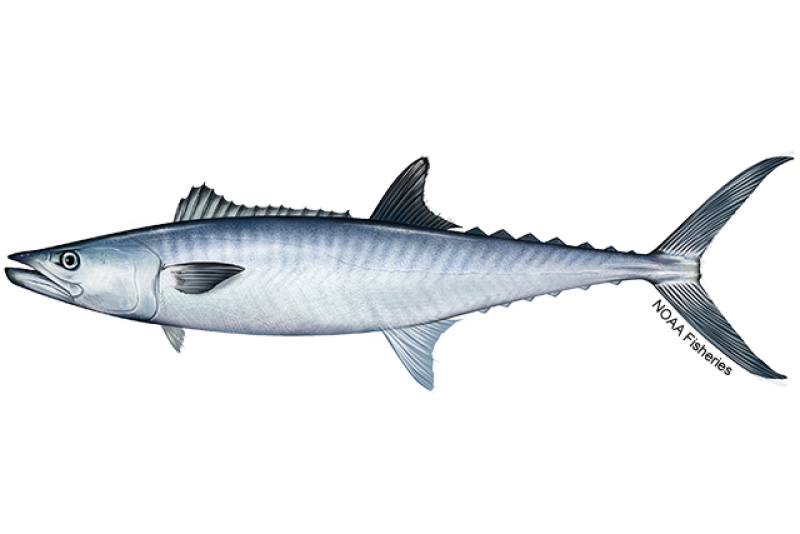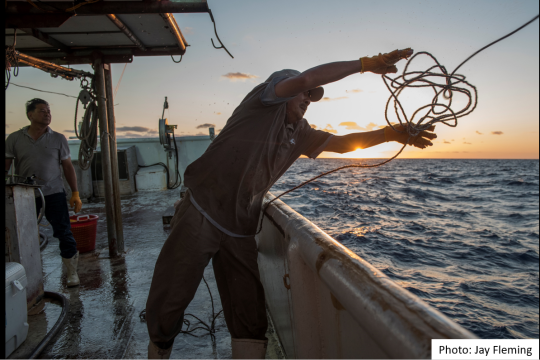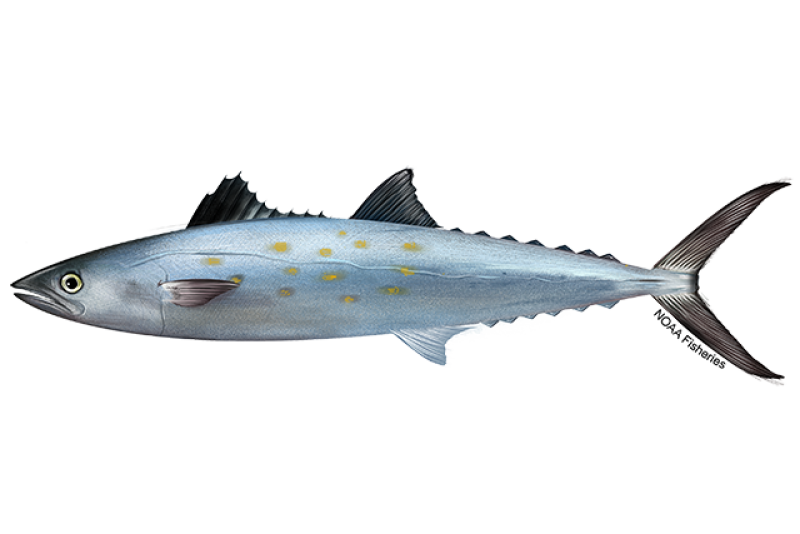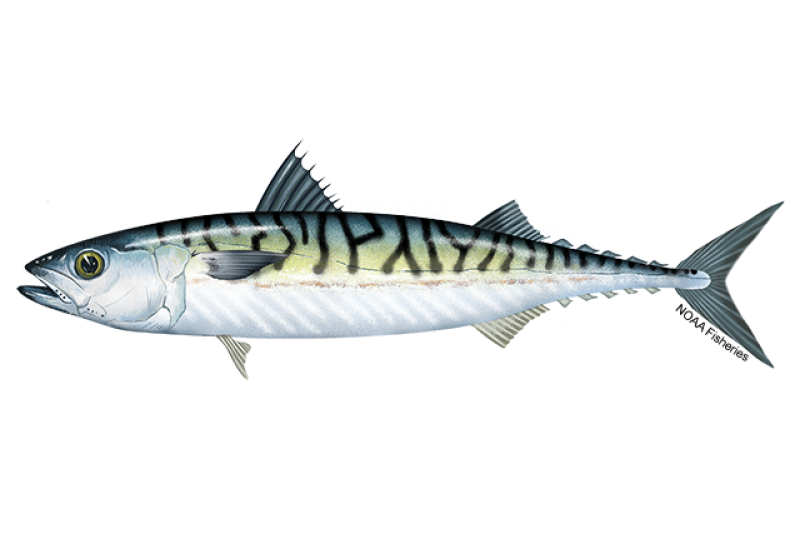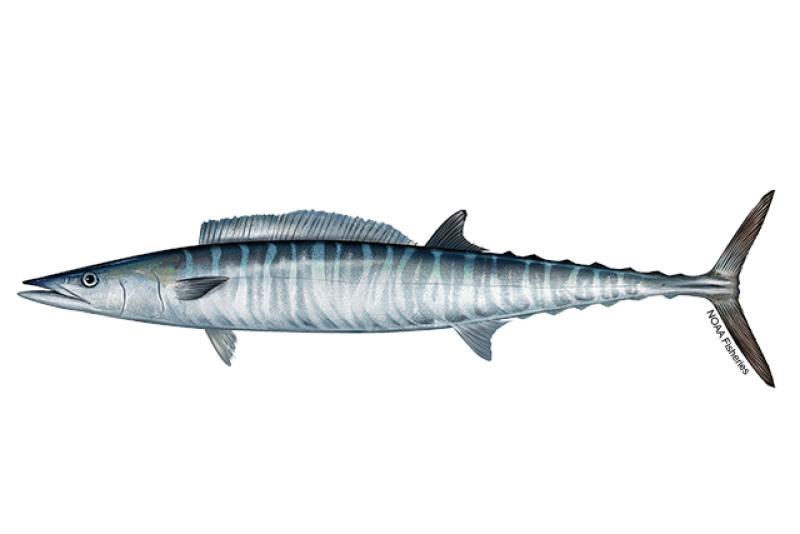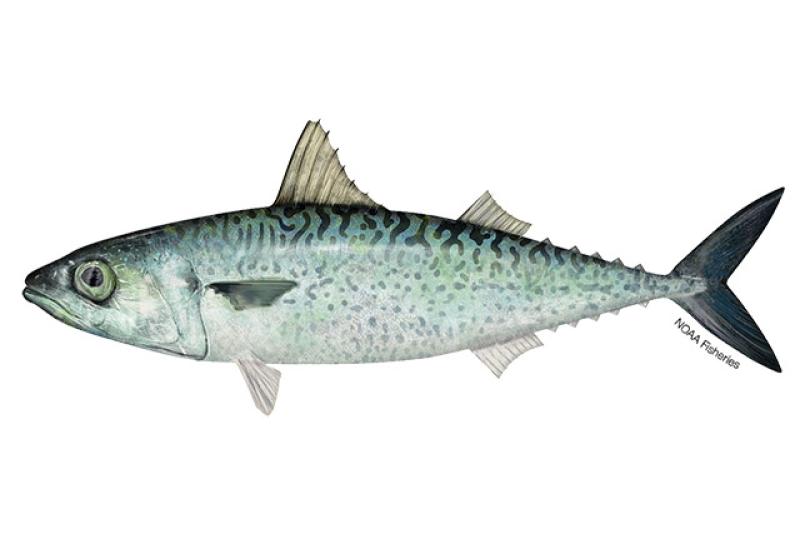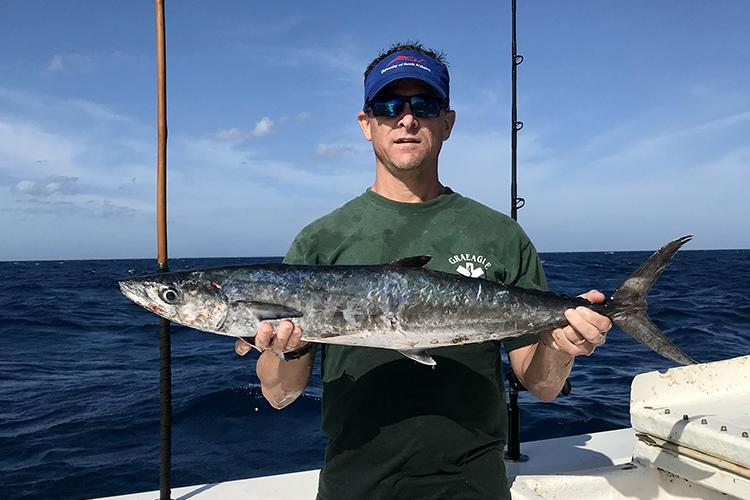 King mackerel. Photo courtesy of Russell Dunn
King mackerel. Photo courtesy of Russell Dunn
King mackerel. Photo courtesy of Russell Dunn
About the Species
 King mackerel. Photo courtesy of Russell Dunn
King mackerel. Photo courtesy of Russell Dunn
King mackerel. Photo courtesy of Russell Dunn
U.S. wild-caught king mackerel is a smart seafood choice because it is sustainably managed and responsibly harvested under U.S. regulations.

Population
The South Atlantic and Gulf of Mexico stocks are not overfished.

Fishing Rate
Not subject to overfishing.

Habitat Impacts
Fishing gears used to harvest king mackerel have minimal impacts on habitat.

Bycatch
Bycatch is low because hook-and-line and gillnet gear is selective.
Population Status
- There are three stocks of king mackerel: a South Atlantic stock, a Gulf of Mexico stock and a stock conained in the Puerto Rico Mackerels Complex. According to the most recent stock assessments:
- The South Atlantic stock is not overfished and not subject to overfishing (2020 stock assessment). Summary stock assessment information can be found on Stock SMART.
- The Gulf of Mexico stock is not overfished and is not subject to overfishing (2020 stock assessment). Summary stock assessment information can be found on Stock SMART.
- King mackerel is contained in the Puerto Rico Mackerels Complex, but it has not been assessed so the population level is unknown. The stock complex is not subject to overfishing, based on 2019 catch data.
- Prior to the 1980s, king mackerel fisheries were essentially unregulated and became depleted. Regulations were implemented in 1983 to control harvest and rebuild declining stocks of king mackerel, and today these stocks have been restored to target population levels.
Appearance
- King mackerel are iron-gray on the back and silvery on their sides and belly.
- They have pale to dusky fins.
- Small king mackerel sometimes have spots like Spanish mackerel, but king mackerel can be distinguished by their sharply dipping lateral line and gray anterior (near the front) dorsal (the upper side) fin.
Biology
- King mackerel grow fast, up to 5.5 feet and 100 pounds.
- They can live more than 20 years.
- They are able to reproduce when they reach 2 years of age.
- There are two distinct populations, one in the Gulf of Mexico and one in the Atlantic.
- They spawn on the outer continental shelf from May through October. Females release eggs in the open water, where they are fertilized.
- Females grow much larger than males, an evolutionary strategy that maximizes the amount of eggs that a female can produce. Females can produce 50,000 to several million eggs.
- King mackerel are carnivores, feeding on fish, squid, and shrimp. They’re voracious feeders and have been observed leaping out of the water in pursuit of prey.
- Juvenile and larger pelagic fish feed on smaller king mackerel. Bottlenose dolphins and large fish, such as sharks and tunas, feed on adult king mackerel.
Where They Live
Range
- King mackerel are found in the Atlantic Ocean from Massachusetts to Brazil, including the Caribbean and Gulf of Mexico.
Habitat
- King mackerel are a coastal pelagic species, meaning they live in the open waters near the coast.
- They live in water 115 to almost 600 feet deep.
- They prefer warm waters and seldom enter waters below 68° F.
- King mackerel migrate with seasonal changes in water temperature and with changes in food availability.
- They migrate to the northern part of their range in the summer and to the southern part in the winter, swimming in large schools.
- Both the South Atlantic and Gulf of Mexico stocks congregate in a winter mixing zone in an area of Monroe County, Florida, south of the Florida Keys, between November and March.
Fishery Management
- NOAA Fisheries and the South Atlantic and Gulf of Mexico Fishery Management Councils manage the king mackerel fishery.
- Managed under the Fishery Management Plan for the Coastal Migratory Pelagic Resources in the Gulf of Mexico and South Atlantic Region:
- Commercial fishermen must have a permit to harvest king mackerel.
- The number of available permits is limited to control fishing pressure on king mackerel.
- Annual catch limits divided between the commercial and recreational fisheries for the Atlantic and Gulf of Mexico stocks.
- Seasonal and per-fishing-trip limits.
- Minimum size limit to allow fish time to mature and spawn.
- Seasons for the Atlantic and Gulf of Mexico stocks. Seasons or areas can close early if quotas are reached.
- Gillnets are prohibited in Florida state waters. They are also prohibited in federal waters, except seasonally in certain areas.
- State regulations are fairly consistent with federal regulations.
Harvest
- Commercial fishery:
- In 2022, commercial landings of king mackerel totaled 3.7 million pounds and were valued at $12 million, according to the NOAA Fisheries commercial fishing landings database.
- A large fraction of the commercial catch is harvested from the “winter mixing zone” in South Florida, which includes Gulf of Mexico and South Atlantic waters.
- Gear types, habitat impacts, and bycatch:
- Most commercial fishermen use hook-and-line gear such as handlines, rod-and-reel, and troll gear. Gillnets are also allowed in limited areas.
- Hook-and-line and gillnet gear have minimal impact on habitat because they do not contact the ocean floor.
- Fishing gear used to harvest king mackerel is very selective, so the fishery has little bycatch.
- Recreational fishery:
- In 2022, recreational harvest of king mackerel totaled 5.6 million pounds, according to the NOAA Fisheries recreational fishing landings database.
- King mackerel is a large, aggressive fish that is popular with recreational fishermen and makes up a large part of the total harvest.
- King mackerel support a valuable tournament fishery.
- Recreational management measures include:
- Minimum size limits
- Bag limits
- King mackerel must be landed with their heads and fins intact.
- Charter vessel/headboat operators must have a vessel permit for coastal migratory fish and must comply with possession limits.
Scientific Classification
- King mackerel are found in the Atlantic Ocean from Massachusetts to Brazil, including the Caribbean and Gulf of Mexico.
- King mackerel are a coastal pelagic species, meaning they live in the open waters near the coast.
- They live in water 115 to almost 600 feet deep.
- They prefer warm waters and seldom enter waters below 68° F.
- King mackerel migrate with seasonal changes in water temperature and with changes in food availability.
- They migrate to the northern part of their range in the summer and to the southern part in the winter, swimming in large schools.
- Both the South Atlantic and Gulf of Mexico stocks congregate in a winter mixing zone in an area of Monroe County, Florida, south of the Florida Keys, between November and March.
Fishery Management
- NOAA Fisheries and the South Atlantic and Gulf of Mexico Fishery Management Councils manage the king mackerel fishery.
- Managed under the Fishery Management Plan for the Coastal Migratory Pelagic Resources in the Gulf of Mexico and South Atlantic Region:
- Commercial fishermen must have a permit to harvest king mackerel.
- The number of available permits is limited to control fishing pressure on king mackerel.
- Annual catch limits divided between the commercial and recreational fisheries for the Atlantic and Gulf of Mexico stocks.
- Seasonal and per-fishing-trip limits.
- Minimum size limit to allow fish time to mature and spawn.
- Seasons for the Atlantic and Gulf of Mexico stocks. Seasons or areas can close early if quotas are reached.
- Gillnets are prohibited in Florida state waters. They are also prohibited in federal waters, except seasonally in certain areas.
- State regulations are fairly consistent with federal regulations.
Harvest
- Commercial fishery:
- In 2022, commercial landings of king mackerel totaled 3.7 million pounds and were valued at $12 million, according to the NOAA Fisheries commercial fishing landings database.
- A large fraction of the commercial catch is harvested from the “winter mixing zone” in South Florida, which includes Gulf of Mexico and South Atlantic waters.
- Gear types, habitat impacts, and bycatch:
- Most commercial fishermen use hook-and-line gear such as handlines, rod-and-reel, and troll gear. Gillnets are also allowed in limited areas.
- Hook-and-line and gillnet gear have minimal impact on habitat because they do not contact the ocean floor.
- Fishing gear used to harvest king mackerel is very selective, so the fishery has little bycatch.
- Recreational fishery:
- In 2022, recreational harvest of king mackerel totaled 5.6 million pounds, according to the NOAA Fisheries recreational fishing landings database.
- King mackerel is a large, aggressive fish that is popular with recreational fishermen and makes up a large part of the total harvest.
- King mackerel support a valuable tournament fishery.
- Recreational management measures include:
- Minimum size limits
- Bag limits
- King mackerel must be landed with their heads and fins intact.
- Charter vessel/headboat operators must have a vessel permit for coastal migratory fish and must comply with possession limits.
Scientific Classification
| Kingdom | Animalia | Phylum | Chordata | Class | Actinopterygii | Order | Scombriformes | Family | Scombridae | Genus | Scomberomorus | Species | cavalla |
|---|
Last updated by NOAA Fisheries on 02/20/2024
Featured News
 NOAA's Office of Law Enforcement patrolling in the Southeast.
NOAA's Office of Law Enforcement patrolling in the Southeast.
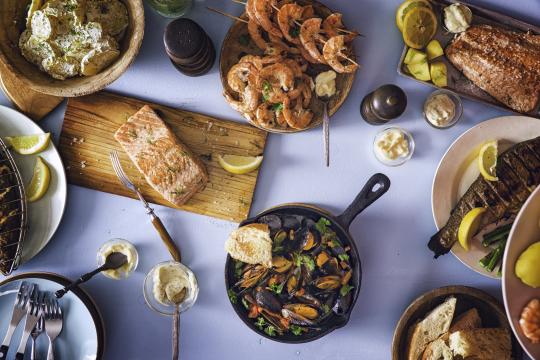 Fish and shellfish dishes. Credit: iStock
Fish and shellfish dishes. Credit: iStock
Seafood Facts

Is King Mackerel Sustainable?
U.S. wild-caught king mackerel is a smart seafood choice because it is sustainably managed and responsibly harvested under U.S. regulations.
Availability
Year-round.
Source
U.S. wild-caught from New York to Texas. The majority of commercial catch is from the Gulf of Mexico.
Taste
King mackerel has a rich, pronounced flavor. For a milder flavor, cut out the outer bands of dark, strong-tasting meat along the midline.
Texture
Flaky and moist.
Color
Raw mackerel is grayish and oily. When cooked, mackerel is off-white to beige in color.
Health Benefits
King mackerel is rich in omega-3 fatty acids, low in fat, and a very good source of protein, riboflavin, niacin, vitamin B12, and selenium. More information on health and seafood.
Nutrition Facts
Servings: 1; Serving Weight: 100 g (raw); Calories: 105; Protein: 20.28 g; Total Fat: 2 g; Total Saturated Fatty Acids: 0.363 g; Carbohydrate: 0 g; Total Sugars: 0 g; Total Dietary Fiber: 0 g; Cholesterol: 53 mg; Selenium: 36.5 mcg; Sodium: 158 mgMore Information
Last updated by NOAA Fisheries on 02/20/2024
Seafood News
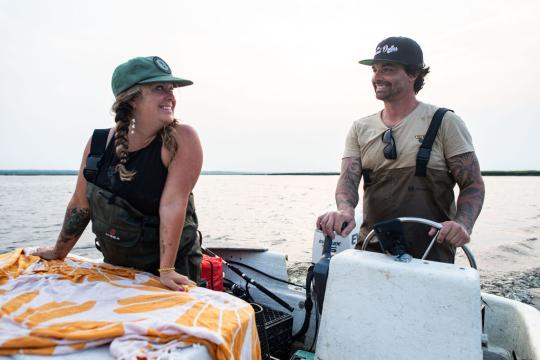 Photo credit: Christine Hochkeppel, christinehochkeppel.com
Photo credit: Christine Hochkeppel, christinehochkeppel.com
 Port of Dutch Harbor and the village of Unalaska in the Aleutian Chain on the edge of the southeastern Bering Sea. Dutch Harbor the largest fishing port by volume in the U.S. Credit: NOAA Fisheries/Paul Hillman.
Port of Dutch Harbor and the village of Unalaska in the Aleutian Chain on the edge of the southeastern Bering Sea. Dutch Harbor the largest fishing port by volume in the U.S. Credit: NOAA Fisheries/Paul Hillman.
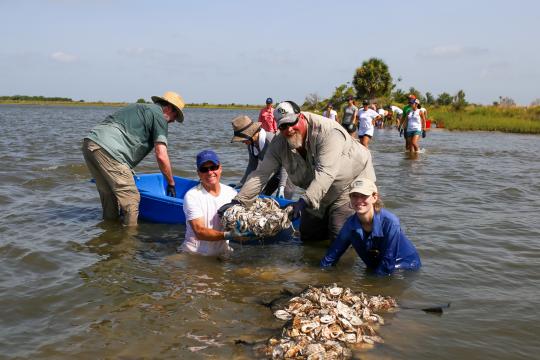 Volunteers build an oyster reef from recycled oyster shells (Photo: Galveston Bay Foundation)
Volunteers build an oyster reef from recycled oyster shells (Photo: Galveston Bay Foundation)
Research
Exempted Fishing Permit: Quantification of Bycatch Composition and Survival in the Commercial Menhaden Purse Seine Fishery
Gulf of Mexico Exempted Fishing Permit. For more information, contact: Dan Luers; (727) 824-5305,Daniel.Luers@noaa.gov or Jennifer Lee at Jennifer.Lee@noaa.gov
Last updated by NOAA Fisheries on 02/20/2024
